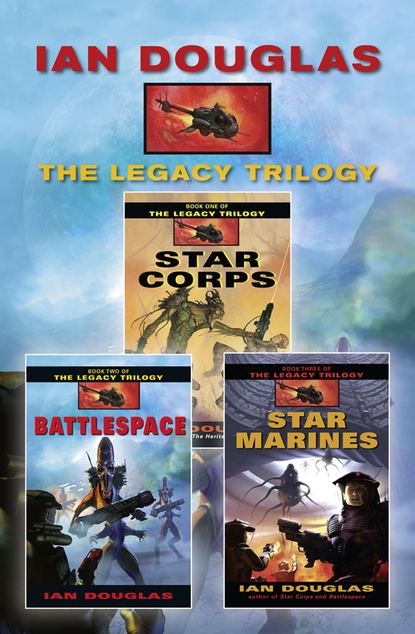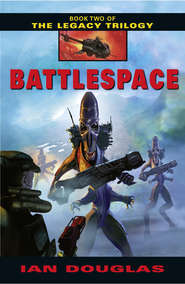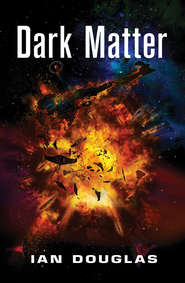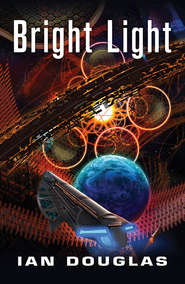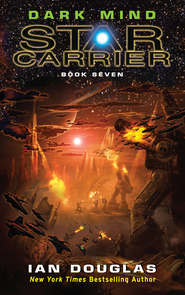По всем вопросам обращайтесь на: info@litportal.ru
(©) 2003-2025.
✖
The Complete Legacy Trilogy: Star Corps, Battlespace, Star Marines
Настройки чтения
Размер шрифта
Высота строк
Поля
The defenders would know that something was happening; even with stealth architecture, the three transatmospheric vehicles had scorched their radar signatures in ion reentry trails across the skies of Western Europe as they’d descended from suborbit, and the mullahs of the True Mahdi had been expecting something of the sort. The only question was how long it would take them to react.
Captain Martin Warhurst, CO of Bravo Company, sat hunched over in his travel seat in the rear of CPC Delta’s red-lit troop compartment, crowded torso to armored torso with the men and women of 1st Squad, First Platoon. There were no windows in the heavily armored compartment, no viewscreens or news panels, but a data feed painted a small, brightly colored image within his Helmet Data Overlay, showing the outside world as viewed through a camera in the TAV’s blunt nose.
There wasn’t a lot to see, in fact—abstract patterns of light and darkness wheeling this way and back with the TAV’s approach maneuvers. The area beyond the Giza complex, along the west bank of the Nile, was brightly lit. The extensive archeological digs behind the Sphinx and between the two northern pyramids, those of Khufu and Khafre, were bathed in harsh spotlights reflected from aerostats hovering high above the ground-based beam projectors.
He knew the mission orders, knew the lay of the land and the location of the company’s objectives, but it was almost impossible to make sense of what he was seeing on his HDO display. Balls of yellow and red light floated up from the ground—fire from enemy antiaircraft positions. Colored lines and symbols glowed among alphanumerics identifying targets, way points, ranges, and bearings. His cranialink provided analysis, based on data jacked through from the CPC’s combat computer. He could see the area marked as the platoon’s drop-off point, midway between the Sphinx and Khafre’s pyramid.
“Captain Warhurst,” the phlegmatic, female voice of the TAV’s AI pilot said in his helmet receiver. “Thirty seconds. Hot LZ.”
“I see it,” Warhurst replied. His grip tightened on his weapon, a General Electric LR-2120 Sunbeam pulse laser, with its M-12 underbarrel 20mm RPG launcher and data hotlink to his Mark VII armor. He’d been in the Marines for six years and made captain two years ago, but this would be his first time in combat, his first hot drop, his first time in command with a live enemy.
God, don’t let me screw it up. …
The TAVs made a final course adjustment, shrieking low above the sands between the middle and southern pyramids, their dead-black hulls slipping through crisscrossing targeting radar beams like ghosts, evading hard locks. Air brakes unfolded like ungainly wings as their noses came up, and billows of sand exploded from the hard-driving plasma thrusters arrayed at wing roots and bellies.
“Hold on,” the AI’s voice said, as deceleration tugged at Warhurst’s gut and the steel deck tilted sharply beneath his booted feet. “We’re going in.”
“Hang onto your lunches, boys and girls,” he called over First Platoon’s comm channel. “We’re grounding!”
A jolt … a moment of suspense and silence … and then another, harder jolt as the TAV decelerated on shrieking thrusters to a slow-drifting hover. With a shrill whine of hydraulics, the first CPC was extruded from the side of the TAV’s fuselage on unfolding davits as raw noise banged and shrieked inside the sealed troop compartment. Plenum thrusters already spooling howled now as all four onboard hovercraft personnel carriers swung free of the floating TAV and detached their cables. Sand blasted around the hovercraft as they floated half a meter above the surface, skittering sideways to clear the overhang of their huge, black transport while the TAV engaged full thrusters and rose clear of the drop zone. “Good luck, First Platoon,” the AI pilot’s voice announced.
“We’re clear of the TAV, Captain!” Lieutenant Schulman, the CPC commander, yelled over the vehicle’s comm system. Hammer blows clanked and pinged and sang from the hull outside. They were taking small-arms fire. “Objective in sight, range two-three-five. Moving!”
“Roger that!” Warhurst’s helmet display feed had shifted automatically to a pickup on the CPC’s hull now that the hovercraft was free of its ride. He could see the flash and wink of gunfire in the darkness, the streaking tracers of heavy automatic weapons. Somewhere in the distance a round of HE went off with a deep-throated crump, briefly lighting the dune shadows nearby. The CPC’s turret shrilled as it rotated in its collar above and forward of the troop compartment, and Warhurst felt the steady thud-thud-thud of the 50mm autocannon slamming high explosive rounds into an enemy gun position.
The armored Marines remained strapped in their seats, weapons muzzle up between their knees, silent while boiler room noise boomed and banged around them. Once, the CPC lurched heavily to the left as a near miss rocked the hovercraft over on its plenum skirts like a boat listing in heavy seas, but Schulman righted the stubborn, tough-hulled machine and swerved hard as armor-seeking missiles strobed in dazzling cacophony outside.
“Coming up on the drop-off, Captain!” Schulman warned. “Ten seconds!”
“Roger that!” He checked the map on his HDO. They were on target. With a focused thought, he shifted to the platoon freak. “Ten seconds, people! Go to IR!”
With a thought focused through his implant, Warhurst engaged his helmet’s infrared overlay, and the red-lit shapes around him faded into gloom, nearly invisible, with only enough heat leakage from joints and peripheral gear to give each Marine in the compartment a faint, ghostly aura.
The hovercraft slewed sideways, and the aft hatch opened up, ramp dropping and shields unfolding to reveal a cold black sky above the grays and midnight blues and black-greens of a chill desert landscape painted in infrared. Warhurst hit the quick release on his harness and was on his feet, ducking to step beneath the hatch. “C’mon, Marines!” he shouted. “Ooh-rah!”
In a double line, twelve Marines stormed down the drop ramp and onto the sand as point-defense lasers on the CPC’s upper deck tracked incoming mortar rounds and flashed them to metallic vapor. Warhurst raced ahead, conscious only of the press of the Marines around him, of the rattle and pop of weapons fire, the flicker of muzzle flashes in front of him.
He threw himself down on the slope of a dune, scrambling up and forward until he could bring his weapon to bear. The 2120’s sighting camera was linked by computer to his helmet display. A red-glowing reticle crosshaired whatever the laser’s muzzle was pointed at, together with flickering numbers giving range, bearing, and probable target ID. He took aim at the muzzle flashes fifty meters to his northeast and thumbed the lever to engage his RPG autolauncher. He let the weapon’s sight record the target—dimly seen shapes of yellow emerging from the inky blue-green backdrop. His computer tagged the guns as teleoperated sentries, but the body heat of a dozen enemy soldiers showed as vague shapes through the dune itself and as pillars of moist heat moving above the sand. Field sensors detected the RF leaked by electrical systems, probably the sentries’ motors and power packs.
Good enough. He squeezed the trigger. The boxlike hard plastic case of the weapon vibrated within the grip of his gloves as he loosed a burst of grenades, cycling at twelve rounds per second, fanning eight rounds in a spread along the crest of the sand dune ahead. Accelerated to eight hundred meters per second by the launcher’s mag driver, each round unfolded in flight, a tiny ramjet engine kicking on as microvanes steered the projectile toward its chosen target. Like steadily glowing fireflies against the night, the string of ramjet-propelled grenades streaked through the darkness, rising high above the sand dune sheltering the enemy gunners, then angling suddenly and sharply down, detonating behind the ridge in a chain of explosions, each as powerful as the blast from a fist-sized lump of CRX-80.
Shrieks and screams rose from the target area as clouds of sand geysered into the sky, mixed with chunks of plastic, metal, and more grisly debris. A running figure showed briefly at the crest of the ridge; Warhurst thumbed his weapon to laser and triggered a pulse. The target flopped out of sight, but Warhurst wasn’t sure whether he’d scored a kill or not.
Explosions continued to thump and boom all around them. The other members of First Platoon had spread out along the dune, laying down a devastating curtain of explosive firepower, driving the enemy gunners to cover.
With a thought, he engaged his helmet’s data link with the CPC. What’s up ahead?
The CPC sensors were far sharper and more observant than those packed in a Mark VII combat armor suit. In addition, Lieutenant Schulman had by now deployed a small army of recon floaters, marble-sized sensor packs riding their magfields across the battlefield, allowing the CPC computer to build up a coherent and complete view of the entire engagement.
A picture inset opened for him at the top of his helmet’s field of view. Symbols moved slowly across a 3D model of the surrounding terrain—green squares, circles, and triangles for Bravo Company’s Marines; reds for known hostiles; yellows for unknowns. Dropping the resolution to a hundred meters, he was able to narrow the feed to just First Platoon, checking on their position, then open it again to the entire battlefield.
The sand dune ahead was clear. No living targets, no operating machinery or electrical devices. The flanks were clear as well, as Second and Third Platoons completed their deployments to either side. “First Section, First Platoon, move out!” he called over the platoon’s command channel. “Second Section, overwatch.”
He was struggling to find the right rhythm of command. In a sense, he was wearing two hats—commander of Bravo Company as well as CO of First Platoon. He couldn’t neglect one for the other and needed to stay well-grounded in the scope and depth of the entire battle.
This despite the fact that he was only directly aware of the fighting in his immediate vicinity, at squad level. Even his HDO electronics and satellite-relayed downlinks couldn’t entirely lift the eternal fog of war.
Scrambling to his feet, Warhurst jogged across the sand until he reached the explosives-chewed berm. A tangle of bodies lay on the far side—Kingdom militia, from the look of them, in a mix of dark fatigues, chamelecloth, and civilian clothing. A black beret on the sand bore the green and silver crescent flash of the True Mahdi. The weapons were mostly Chinese lasers and Shiite Persian K-90s; the charred and scattered fragments of casings, ammo boxes, and squat tripods were probably the remnants of Chinese Jixie Fangyu automated sentry guns, JF-120s.
The two squads of First Section fanned out along the slope, providing cover as Second Section moved up to join them. Ahead and to the left a blaze of light showed eerily luminescent in Warhurst’s IR view. Several man-sized heat sources jogged past the base of a small building with lighted windows. He raised his weapon, switching to RPG and tracking the figures, but a targeting interrupt appeared on his helmet display, blocking the shot. The targets were hostiles, no question of that; he’d thought for a moment that his weapon had detected the IFF signatures of other Marines moving into his field of fire. The readout said otherwise. The company’s primary objective lay in that direction, just behind the building. His rifle was telling him that a miss might cause unacceptable collateral damage.
Slapping the selector switch back to laser, he triggered a stuttering burst of laser fire on the hostiles, scoring at least one hit. He saw the man beneath the targeting crosshairs flail wildly and go down. The rest appeared to be scattering back across the desert, toward the river.
Advancing again by sections, First Platoon rushed forward, taking small-arms fire from the building but nothing powerful enough to more than ding their armor. A five-ton cargo hovertruck lay on its side half buried in the sand, its turbine box blazing against the darkness. The twelve CPCs drifted slowly among the dunes, laying down intense covering fire. Overhead, the airborne TAVs darted and hovered like immense black dragonflies while the ground units called down fire from the sky.
Warhurst ran up to the building, a squared-off office module of the sort designed to be moved by truck or floater to where it was needed temporarily. Throwing himself down on the sand, he took aim at the single door. “Come out!” he yelled. At his mental command, his suit’s comm suite translated his words into Arabic. “Yati!”
Other Marines joined him, and a burst of automatic fire snapped from the module window. Warhurst sent a burst of laser pulses back in reply, burning through the thin plastic walls of the building and eliciting shouts and screams inside.
Someone shouted something in guttural Arabic, and Warhurst’s suit translated: “Do not shoot! Do not shoot!” A moment later the door banged open and two KOA troops stumbled out, holding their Chinese lasers above their heads. A moment passed, and two more emerged, supporting a third man, a wounded comrade, between them.
“Out! Out!” Warhurst yelled, and Sandoval and Kreuger leaped forward. They pulled the weapons from the prisoners’ hands, tossed them aside, and shoved the captives back and away from the building. Michaelson and Smith banged through the door and rolled inside, checking the building, then emerged again to report it secure.
Gunfire crackled in the distance as Second and Third Platoons established a company perimeter. At the building, though, there was momentary peace, an eerie calm. After ordering Kreuger to keep watch on the prisoners, now lying facedown on the sand a few meters away, Warhurst checked in with his other platoon commanders. Both reported the enemy on the run, light casualties, and a secure regimental LZ. Gunnery Sergeant Petro reported that First Platoon now controlled the main objective. The defenders were fleeing … or had been neutralized, one way or another.
Walking out across the desert toward the company’s objective, Warhurst opened the command channel. “Backstop, Backstop, this is Sharp Edge One. Objective Stony Man secure.”
“Sharp Edge One, Backstop. Roger that. You have some people back here who’ve been holding their breath ever since you went in.”
“Well, don’t let them breathe yet. There was heavy—repeat heavy—enemy activity in the LZ.” So much for that easy in, easy out op they’d promised, Warhurst thought. “Local resistance has been broken, but I don’t want to get too fat and happy out here.”
Just ahead, Objective Stony Man rose from a broad, steep-walled pit carved into hard-packed sand and limestone bedrock … a long, low, weathered body lying on a pedestal like a crouching lion … the head ancient, secretive, facing east across the black sparkle of the Nile.
The Sphinx of Giza, sentinel of the Great Pyramids, still silent after all these millennia. He could make out a faint, reflective gleam from the plastic shell that had been added a century ago to prevent further erosion.
Warhurst’s proximity motion detector chirped at him, and he turned in the indicated direction. A small, gray sphere, marble-sized and pulsing with a superconductor-driven magnetic induction field, was moving left to right ten meters away. He brought his weapon up, but his targeting interrupt cut in. The object IFFed as a Net News Network remote camera.
Damn, he thought, Triple N, as usual, had better intelligence than the Pentagon. How the hell had they picked up on the Giza op so quickly?
He considered overriding the cutouts and bringing the camera down. Troops in the field had the right to do so if a wandering news camera might reveal positions or movements to the enemy. In fact, the mullahs across the Nile in Cairo were probably watching live Triple N news coverage at that moment. He resisted a comic-relief impulse to wave.
Still, the networks were generally pretty good about keeping their equipment back from the immediate front lines, if only because those flying robotic eyes were damned expensive and tended to draw fire. If newsies were around, it was a good sign that the enemy wasn’t. Anyway, the one he’d seen was traveling at a pretty good clip, heading toward the river. He let it go.
Warhurst returned his attention to the Sphinx once more. After a moment’s thought, he slung his weapon, then reached up and unsnapped the catches on his combat helmet. He wanted to see that ancient wonder with unaugmented eyes.
The light surprised him and made him blink. The sky was bright and pale blue, only minutes from sunrise. The Sphinx continued to stare at the eastern horizon, as though patiently waiting for yet another in a chain of three million dawns.
He turned then, facing west, and caught sight of a glorious panorama—the three pyramids rising above the Giza Plateau; the nearest, Khafre’s, just two hundred meters away. The upper half of each glowed a brilliant orange-yellow, bathed in light from a sun still below the horizon; the lower halves were still gray with night shadow.





